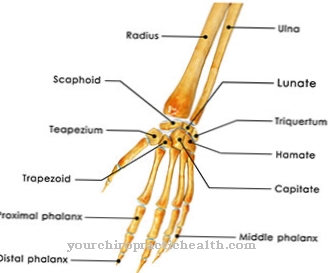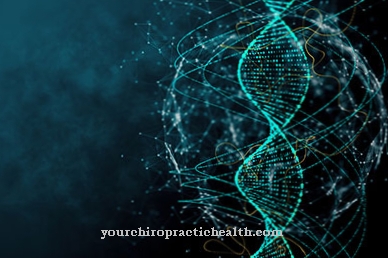People used to be under Giant growth or. Hypersomia suffered, often marginalized and exhibited as an attraction. It was only in the past century that this attitude slowly changed and giantism was recognized as a disease.
What is giant growth?
.jpg)
© sakurra - stock.adobe.com
Giant stature describes an extraordinary body size that is enormously above average. Basically, those people are seen as gigantic who are among the three percent of the tallest in their age and gender class.
More specific classifications relate to the cause of the enormous growth. Hormonally induced gigantic stature, for example, is referred to as hypophysial gigantic stature, whereas genetic stature is called primordial tall stature. Other names for giant stature are hypersomia and gigantism.
A special form of giant growth is acromegaly, in which only the extremities and the acra of the body such as feet, ears, eyes or chin are enlarged. Giant growth is a very rare phenomenon in Germany. Every year around three to four of every million people become ill.
root cause
The most common cause of giant stature is hormonal imbalances. This imbalance can have various triggers. During the growth phase, the pituitary gland, which is responsible for the production and release of growth hormones, can be disturbed.
When this happens, it releases too much growth hormones, which leads to uncontrolled growth of the body. In most cases, the reason for this disorder is a benign tumor in the pituitary gland. Tumors in the pancreas can also have an effect on growth, as growth hormones are also produced there.
However, tumors are not always responsible for hypersomia. Congenital overactive thyroid gland (hyperthyroidism) or diabetes in the mother during pregnancy can also lead to giant growth in infants, because the hormonal balance is also subject to disorders. The extremely rare triggers for gigantism also include genetic defects such as Klinefelter syndrome, in which men have an additional X chromosome.
Symptoms, ailments & signs
The characteristic feature of gigantic stature is a height that is well above average. The average value depends on ethnicity, age and gender. A form of hypersomia is when the height is in the first percentile. As a rule, if you are a giant, all parts of your body grow proportionally to your height.
However, there are some forms of the disease in which only the extremities and tips of the body become longer than average. In many cases, giant stature is already noticeable in babies and children. They often suffer from growing pains. Babies and toddlers often cry for this reason.
This pain persists into early adulthood and can become unbearable for some patients. Depending on the type and severity of the giant stature, those affected often develop poor posture. These cause additional pain and physical limitations. Often there are visible deformities. Another common symptom is joint pain.
If the giant stature is hormonal, a number of other complaints can occur. In many cases the internal organs are damaged. The liver and kidneys are particularly often affected. In addition, affected children and adolescents are sexually mature noticeably early. The secondary sexual characteristics are often very pronounced in them before the age of ten.
Diagnosis & course
Home remedies ↵ for joint
pain
The most obvious symptom of giant stature is an enormously above-average height, which often already exists in early childhood. In addition, there is often severe pain during growth and violent growth spurts. The diagnosis of giant stature is made on the basis of evaluations of the blood values in the laboratory. If these show a strong imbalance in the hormone levels, further examinations such as magnetic resonance imaging or X-rays are ordered. In this way, pathological gigantism can be differentiated from natural, purely genetic, above-average growth.
The course of the disease with giant stature is very different and always dependent on the severity and therapy options. The rapid and uncontrolled growth places the greatest strain on the skeleton and with it the bones. Bone growth is often not uniform and can lead to serious misalignments and postural damage, which are often accompanied by severe headache and joint pain.
In addition, the disturbed hormone balance also affects the internal organs such as the kidneys or liver. In many cases, gigantic children are sexually mature prematurely. Secondary sexual characteristics then begin to develop before the age of ten. Despite better treatment options, the average life expectancy of tall people is still well below that of normal-sized people.
Complications
One of the biggest complications of being a giant is bad posture. The rapid and uncontrolled growth puts a considerable strain on the bones and leads to malpositions, which are often associated with severe headache and joint pain. The characteristic bulges and enlargement of the nose are also typical.As a result of macroglossia, i.e. the enlargement of the tongue, there is an indistinct pronunciation.
These abnormalities often result in psychological distress as well. Giant stature is usually associated with inferiority complexes and depression. The disturbed hormonal balance overloads the internal organs such as the kidneys and liver. Giant children also reach sexual maturity prematurely and also have a reduced life expectancy. If the hypersomia is based on a pituitary tumor, other complaints such as visual disturbances, visual field defects and neurological disorders can arise.
The tumor disease is rarely fatal. The treatment of giant stature can lead to a variety of complications, depending on the therapy method chosen. Chemotherapy can have long-term consequences such as organ damage and hormonal disorders. Hormone therapy can also cause hormonal imbalances and lead to premature menopause in women. A surgical procedure is generally associated with risks (for example injuries and bleeding).
When should you go to the doctor?
Hypersomia should always be evaluated by a doctor. This disease does not self-heal. As a rule, hypersomia cannot be treated properly either, so that the person affected only has to rely on purely symptomatic treatment. Complete healing cannot be achieved. In most cases, hypersomia does not have a negative impact on the person's life expectancy. A doctor should be consulted if the patient suffers from overgrowth. Those affected are very large, and the limbs are usually very long.
Also, very severe pain during growth often indicates hypersomia and should always be examined. An examination by a doctor is also very useful if you have pain in the joints. Usually, the hypersomia can be diagnosed by a pediatrician or a general practitioner. The treatment itself is always based on the exact complaints and their severity, so that no universal prognosis can be given.
Treatment & Therapy
Treating giant stature requires successful treatment of the underlying condition. The most common trigger, pituitary tumor, can be treated by a number of different methods. Since operations near the brain involve great risks, an attempt is often first made to fight the tumor with radiation or chemotherapy.
If, on the other hand, the tumor is malignant in one of the very rare cases, neurosurgical intervention is unavoidable. The procedure is similar for a tumor in the pancreas. In addition to treating the tumor, hormone therapy is often prescribed to inhibit growth. Estrogens and gestagens are then used in female patients, and testosterone in male patients. If the risk of a giant stature due to gestational diabetes is increased in the mother, the mother must be treated optimally throughout the pregnancy in order to prevent the embryo from overgrowing.
Basically, the earlier treatment of the trigger begins, the greater the chances of an uncomplicated course of the disease. If treatment is only carried out at an advanced stage or after the end of the growth phase, permanent postural damage can often no longer be averted. In this case, an orthopedic surgeon can only try to treat the already existing ailments.
You can find your medication here
➔ Medicines for joint painprevention
Since attitudes towards gigantic people as well as treatment options have improved significantly over the past few decades, those affected can now be treated much more efficiently and successfully. Nevertheless, early detection remains the most important thing, which is why a doctor should be consulted if there are slight signs of giant growth.
Aftercare
Those affected by giant stature (hypersomia) stand out for a lifetime due to their above-average size. The disease is congenital and is triggered, among other things, by an excessive release of growth hormones. Body size can only be counteracted to a limited extent through operations or the administration of appropriate hormones, and those affected permanently stand out from the crowd. For this reason, aftercare is mainly provided in a psychotherapeutic form.
A specialist will first determine the cause of the giant growth. Various hereditary diseases or hormonal disorders are possible for this. The causal disease cannot be remedied afterwards if it is congenital. In the case of hormonal overproduction, appropriate therapy can counteract a further growth spurt.
To do this, the patient must still be in the growth phase. If the giant stature is accompanied by pain in the joints, the controlled administration of painkillers is recommended. Psychotherapy can help with the giant stature disease to get a better grip on existing emotional complaints.
The aim is to prevent depression due to low self-esteem. The person concerned learns to cope with his or her peculiarities in everyday life. His self-confidence should be strengthened and stabilized. The therapist must convey to the patient that despite his size, he is by no means 'wrong' compared to an average person, but only different.
You can do that yourself
The possibilities of self-help are small with a huge growth. There are no alternative healing methods or self-administered measures that lead to a reduction in physical growth. Since the growth process takes place in the first years of life, those affected can hardly take initiatives on their own that lead to a cause research or change. They are dependent on the support and help of legal guardians or relatives.
The prospect of changes is only possible in close cooperation with a doctor and the patient. It is therefore necessary to consult a doctor in the first few years of life. An attained physical growth can no longer be corrected. Therefore, those affected by the giant stature should develop various strategies that contribute to a fulfilled life and a strengthening of the quality of life despite the visual anomalies.
Mental strength, a stable self-confidence and the healthy handling of physical characteristics are important in order to avoid discomfort or mental disorders in the course of life. If there are problems with the joints, rest periods and breaks should be taken in good time. It is also advisable to work with a physiotherapist. Exercises that are specially tailored to the needs of the patient can be carried out independently and on a daily basis. They serve to alleviate symptoms and improve general well-being.

.jpg)























.jpg)


